This next post in the analysis of disruptive scenarios focuses on next generation automation enabled by combinatorial innovation. By way of reminder, the visual below depicts a convergence of innovations that have historically been viewed in isolation. As the building blocks of innovation multiply, their combination drives disruptive scenarios. By analyzing these scenarios, future implications and potential responses are determined.
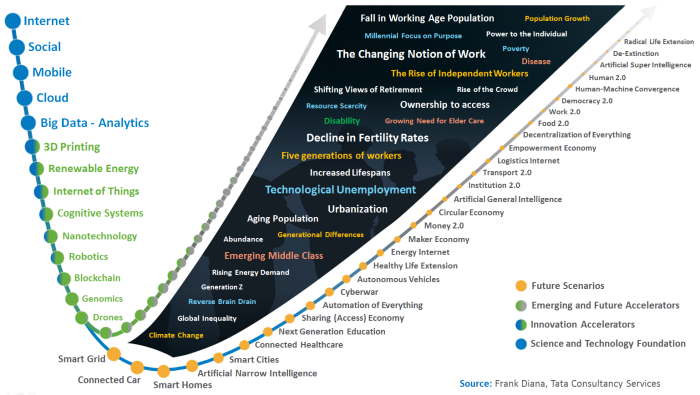
What are the key innovations that combine to enable the next generation of automation? A recent forward looking McKinsey report assessed the potential impact of Disruptive Technologies, providing a perspective focused on the year 2025. Looking at their list of twelve disruptive technologies, I see five primary drivers of advanced automation: the automation of knowledge work, advanced robotics, autonomous vehicles, the Internet of Things, and the mobile Internet. Based on McKinsey sizing, these five disruptive technologies could have an economic impact between $14 and $30 trillion.
Collectively, these innovations enable us to broaden and deepen the applications for automation. While there are many obstacles and challenges to overcome, it is safe to assume that it is the magnitude of change that is in question – not the likelihood of change. This advancement in the level of automation creates another series of disruptive scenarios that impact society, business, government, and the environment. Let’s take a look at each innovation area and its ability to influence these automation applications.
Automation of knowledge work
In my transformation series last year, I discussed the automation of knowledge work as both an emerging enterprise disruptor, and future enterprise enabler. The foundation for this automation lies in the promise of Cognitive Computing. In its simplest form, cognitive computing allows a natural language-based question and answer model that supports action, smarter decision making, and optimal outcomes. Gartner weighed in with their recent 2013 Hype Cycle on the relationship between humans and machines. The focus – driven by the increased hype around smart machines, cognitive computing, and the Internet of Things – is rooted in the belief that the divide between humans and machines is narrowing. Ultimately, machines will replace, augment, or work alongside humans.
We have assumed till now that knowledge work is the sole domain of humans. However, as McKinsey points out in the above mentioned report, knowledge work automation is not just viable – but likely. McKinsey defines this automation as the use of computers to perform tasks that rely on complex analyses, subtle judgments, and creative problem solving. Several advances are combining to create an enabling platform: innovation in data storage, Big Data, Cloud Computing, computational speed, machine learning, cognitive computing, and natural language interfaces. With less human involvement, computers can learn and improve as they perform their tasks. As we’ve seen with Siri and Google Now, advances in speech and gesture recognition allow computers to respond to human commands. The resulting cognitive systems will change the way humans interact with computers, supporting knowledge work through assistance, understanding, decision making, and discovery. Some potential knowledge worker occupations impacted are:
Cognitive systems use natural language processing and machine learning to extend and magnify human expertise and cognition and enable people and machines to interact more naturally. Knowledge workers will reap the benefits of this interaction via more timely access to information and better more timely decision making. While cognitive systems will not think for us, they provide us with insight and free us to think more creatively. This search for insight has in most cases required specialized training such as knowledge of query languages. But a computer’s ability to answer unstructured questions posed in ordinary language enables anyone to get information on their own. This presents the opportunity to change how knowledge work is organized and performed; augment highly skilled employees; or fully automate their jobs.
As a brand new automation category, the focus on knowledge work broadens and deepens our ability to automate. According to McKinsey, the knowledge work automated could equal the output of 110 to 140 million full-time equivalents – generating as much as a $5.2 to $6.7 trillion economic impact annually by 2025. They looked at a subset of knowledge worker occupations with employment costs that could reach $14 trillion by 2025. This included professionals, managers, engineers, scientists, teachers, analysts, and administrative support staff – a group that represents some of the most expensive forms of labor and performs the most valuable work in many organizations. As Geoffrey Moore describes when talking about systems of engagement, these workers were largely ignored as systems of record were deployed in the last quarter century.
Other key knowledge and interaction worker information from the McKinsey report:
- The lion share of economic impact could be generated in advanced economies where wage rates are higher
- Knowledge and interaction worker productivity gains of 20 to 25 percent could be realized by the use of social technologies for better communications and collaboration
- Assuming that interaction workers spend about 25 percent of the work week away from their desks, mobile Internet access could improve their productivity by 4 to 5 percent
- Many common business functions involve answering questions or carrying out tasks for other workers or customers – many of these activities are automatable. Possible productivity gains of 40 to 50 percent could be achieved for the 125 million knowledge workers in this category by 2025, which would lead to economic impact of $1.7 to 2.2 trillion per year
- Currently available personal assistants such as Apple’s Siri and Google Now illustrate some of the possible uses of these technologies in administrative support roles
- Likely areas of knowledge work automation:
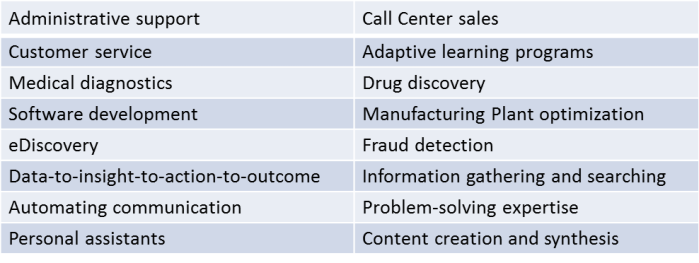
Advanced Robotics
Robotics in the past few decades has been the purview of industrial robots focused on automating manual labor. They have been anchored, expensive, large, inflexible, and fenced off to protect workers. Advanced robots have greater mobility, dexterity, flexibility, intelligence, and adaptability, and can learn from and interact with humans. Enabled by accelerating advancements in sensors, actuators, machine vision, artificial intelligence, and communication, they represent another opportunity to broaden and deepen automation. Their compactness, adaptability, and ability to make complex judgments allow them to work safely alongside humans. These advances could make it practical to substitute or augment humans with robots for a wider range of jobs, while also enabling new types of surgical robots, robotic prosthetics, and exoskeleton braces. These prosthetics and braces will allow people with limited mobility to function more normally, helping to improve and extend lives. Mckinsey estimates that by 2025, there could be more than 50 million people with impaired mobility in the developed world, including amputees and elderly people. In addition, advanced robotic surgery could reduce death rates resulting from major surgeries by 2025. McKinsey estimates that if 5 to 15 percent of all major surgeries are performed with robot assistance, it could result in 60,000 to 180,000 lives saved each year and a 50 percent cut in hospital stays associated with surgery.
With the prices of robots dropping, their use becomes more viable. McKinsey notes that the price of robots has declined 10 percent annually in recent decades and may decline at faster rates through 2025. They estimate the application of advanced robotics could generate a potential economic impact of $1.7 to $4.5 trillion per year by 2025. Advanced robotics could deliver competitive advantage for early adopters, while at the same time lowering the barriers for new competitors. This mixed bag of positive and negative implications also plays out in developing economies that are negatively impacted by falling demand for low-wage manual labor, yet still estimated to be the biggest buyers. Some production for instance could move back to advanced economies and drive demand for higher skilled jobs.
The range of potential applications is expanding. Greater awareness and an ability to communicate with one and other allow advanced robots to work together in teams. McKinsey estimates that the use of advanced robotics for industrial and service tasks could produce the output of 40 to 75 million full-time equivalents by 2025. They expect China to become the world’s largest consumer of industrial robots in 2014 – driven by increases in wages and an improving standard of living. Some of the application areas for advanced robotics are:
 There are barriers to adoption however. The impact of advanced robotics on employment could lead to social and political resistance, and if policies are adopted to protect manual workers, it could limit the economic impact. On the other hand, the talent required to operate and maintain advanced robots may not be available, requiring training and re-skilling. Questions regarding liability will surely arise when robots are involved in accidents or injuries, and although costs are declining, robots are still expensive.
There are barriers to adoption however. The impact of advanced robotics on employment could lead to social and political resistance, and if policies are adopted to protect manual workers, it could limit the economic impact. On the other hand, the talent required to operate and maintain advanced robots may not be available, requiring training and re-skilling. Questions regarding liability will surely arise when robots are involved in accidents or injuries, and although costs are declining, robots are still expensive.
Autonomous Vehicles
The previously referenced McKinsey report includes the autonomous vehicle in their list of disruptive technologies. I discussed this scenario at length in a recent post and include it here as a major driver of next generation automation. McKinsey describes how aircraft and cargo ships already have autonomous features, and expect cars and trucks to join the revolution. They expect a total economic impact between $200 billion and $1.9 trillion by 2025. Several examples are included in the McKinsey report, including the potential to improve the economics of trucking. There are a number of automation applications that are enabled by several types of autonomous vehicles:
For more on this disruptive technology, see this post titled: Autonomous Vehicles – A Disruption Case Study
The Internet of Things
The embedding of sensors and actuators into physical objects is rapidly bringing these objects into the connected world and creating the often discussed Internet of Things (IoT). The applications enabled by IoT over time are numbered and varied. These applications are a critical component of next generation automation strategies and likely enable new levels of productivity, optimization, new types of products and services, new strategies, new business models, and better decision making. Some examples of application areas are:
McKinsey estimates that the Internet of Things has the potential to create an economic impact of $2.7 to $6.2 trillion annually by 2025. For example, remote healthcare monitoring can make a big difference in people’s lives while attacking rising healthcare costs. The ability to monitor and control power grids and water systems impacts energy conservation, greenhouse gas emissions, and water loss. By using sensors to gather information, public-sector functions like garbage collection are made more efficient.
The widespread adoption of IoT will take time, and realizing its full potential will not be easy. As with the other innovation areas, the Internet of Things has a number of barriers to overcome. The primary obstacle will be the inability of organizations to deal with the resulting flood of data. Perhaps the biggest barrier to just about any combinatorial innovation is an inability to analyze data in a way that enables human decisions or automated actions. Privacy and security concerns also stand in the path of realizing the full benefits of IoT. Additional barriers to adoption include cost, the need for sensor-driven business models that deliver superior value, the need for standards and interoperability between sensors, computers, and actuators.
Mobile Internet
The mobile Internet explosion has fundamentally changed the way we interact with the world. Yet it is still early days, and its ability to connect up to three billion more people promises significant future disruption. McKinsey estimates an annual economic impact between $3.7 and $10.8 trillion globally by 2025. Some of this value comes from productivity increases associated with new automation related applications.
In sizing the economic impact of the mobile Internet, McKinsey looked at worker productivity across interaction workers and transaction workers. They estimate a 4 to 5 percent efficiency increase for interaction workers through the use of social and mobile technology. For transaction workers, the gains are greater, driven by increased productivity enabled by time saved accessing information. Here, gains between 10 and 30 percent are possible. Mobile applications could have considerable impact on improving internal operations. For example, mobile Internet devices can be used to manage equipment and physical assets more effectively, monitor supply chains, maintain the condition of vital equipment, and provide post sale services. McKinsey provides examples of Boeing and BMW who have developed virtual reality glasses for assemblers that display online manuals and instructions that explain how parts fit together.
Next Generation Automation
These combinatorial innovations will enable a next generation of automation that has structural implications. The automation of knowledge work for example will impact business models, roles, processes, policies, organization structures, and operating models. While the benefits of a broader and deeper level of automation are many, leaders must assess the implications and evaluate how they might introduce these new forms of automation. Questions need to be answered, including: what tasks will be augmented? Which will be fully automated? How are roles altered? How are organizational processes impacted? As traditional enterprise structures are re-imagined, the impacts can be profound.
As new market entrants, Internet Companies, and start-ups leverage next generation automation, the disruptive pressures on traditional companies grows. Addressing these disruptive pressures is one of the compelling reasons for leaders to analyze automation scenarios and understand both their application and implications. But there are other benefits for businesses including significantly reduced labor costs, greater flexibility, and reduced time to market. Some companies may find it cost effective to repatriate manufacturing operations and position them closer to final assembly and consumers. Entirely new business models are possible, and new high skill employment opportunities may emerge – but so too will the loss of existing jobs. In healthcare, automation could improve patient care and outcomes, and other societal benefits are possible across a wide spectrum.
So next generation automation – enabled by combinatorial innovation – is one of those disruptive scenarios that is in our line of sight, but far enough on the horizon where no burning platform exists. As is the case with each of the scenarios in this category, experimentation in these early days is critical. Leaders everywhere should look at these promising innovations with an eye towards the structural change that is sure to follow. Analyze these scenarios, experiment and understand your response. A very good approach to follow was outlined in this post titled Large Companies and Innovation. The next post will focus on another disruptive scenario.

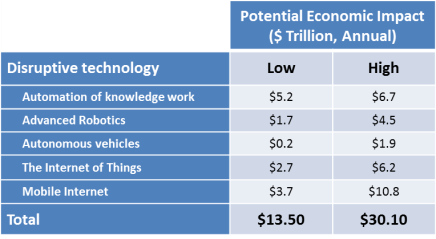

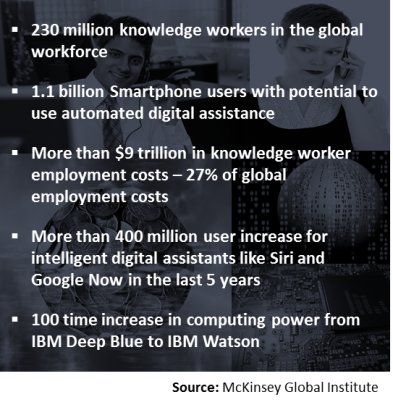
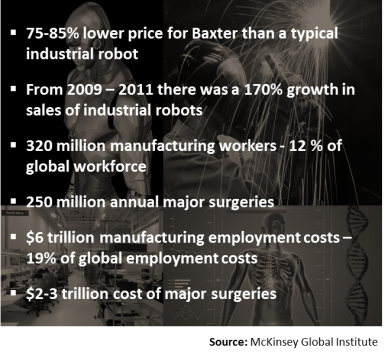

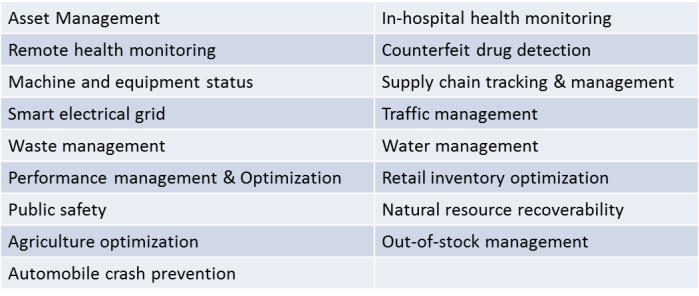
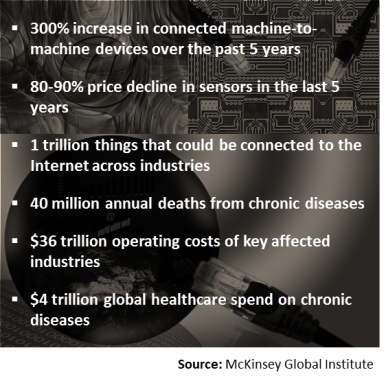

[…] This next post in the analysis of disruptive scenarios focuses on next generation automation enabled by combinatorial innovation. By way of reminder, the visual below depicts a convergence of innov… […]
LikeLike
[…] This next post in the analysis of disruptive scenarios focuses on next generation automation enabled by combinatorial innovation. By way of reminder, the visual below depicts a convergence of innov… […]
LikeLike
[…] by DigitalEnterprise [link] […]
LikeLike
[…] companies go out of business and drive massive unemployment? I explored this in my post on Next Generation Automation. As more tasks are automated; a re-skilling of the workforce is required. Some analysts believe […]
LikeLike
The core problem is the inability of society to devise a workable solution to the continuaous displacement of human workers by the above system of systems and their loss of purchasing power in aconsumer based economic model. What Mc Kinsey describes is simply an extension of that problem to the professional and managerial classes. I suggest you turn Watson loose on that problem before we arrive at your hypernet with robot extensions or it ain’t gonna be pretty.
LikeLike
Can Watson read me this article..can google …guess I’ll have Siri do it ..
LikeLike
[…] Read more from Frank Diana’s Blog […]
LikeLike
[…] A powerful Nicholas Carr piece on how ‘automation makes us dumb’, via the WSJ, and a related piece by Frank Diana on Next Generation Automation […]
LikeLike
[…] Diana, F. (n.d.). Next Generation Automation. Retrieved from wordpress: https://frankdiana.wordpress.com/2014/04/16/next-generation-automation/ […]
LikeLike
[…] Diana, F. (n.d.). Next Generation Automation. Retrieved from wordpress: https://frankdiana.wordpress.com/2014/04/16/next-generation-automation/ […]
LikeLike
[…] Diana, F. (n.d.). Next Generation Automation. Retrieved from wordpress: https://frankdiana.wordpress.com/2014/04/16/next-generation-automation/ […]
LikeLike
[…] productivity gains are driven by automation, structural re-imagination, decentralization, and an ability to rapidly combine building blocks […]
LikeLike
[…] a Post from 2014, I explored the path of automation and a possible economic impact between $14 and $30 […]
LikeLike
[…] scenario defined: if the full tipping point referenced earlier is realized, we will live in an Automated Society. There are several levels of automation that range from augmenting humans to human-machine […]
LikeLike
[…] article above argues that the pandemic will lead to an automation boom. An Automated Society is a future scenario that I have explored in detail. As with each scenario, timing is a big […]
LikeLike
[…] pandemic has made the need for this very visible. The hope is that this realization leads us to a Next Generation of Automation. The more autonomous an organization, the more aligned it is with the speed of […]
LikeLike
[…] future scenario that I describe is called an Automated Society. There is always much skepticism when the scenario is discussed. Our mind tells us that humans do […]
LikeLike
[…] in 2014, the thought of advancements in automation was picking up steam. I wrote about a Next Generation Automation and focused on five primary drivers of advanced automation: the automation of knowledge work, […]
LikeLike
[…] automated society is an impactful future scenario. In the short term, advances in robotics and artificial […]
LikeLike